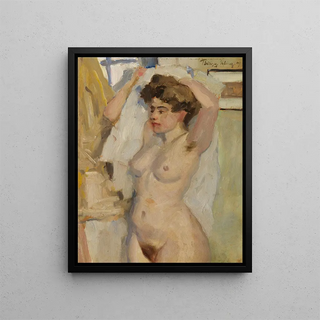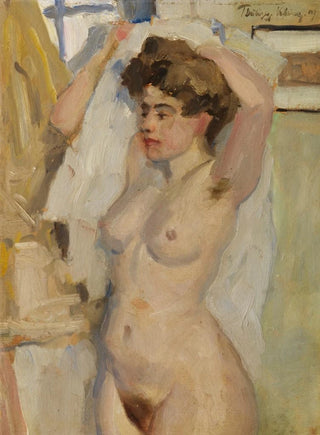Art print | Study of Act I - Philipp Klein


View from behind

Frame (optional)
Study of Act I - Philipp Klein – Captivating Introduction
The artwork "Study of Act I" by Philipp Klein invites viewers into an artistic universe where deep emotions blend with refined technique. This piece, often seen as an exploration of the nuances of the human condition, stands out for its ability to evoke intense and complex feelings. Through this art print, the viewer is transported into a silent dialogue between the subject depicted and the observer, an interaction that echoes the very essence of art. The work does not merely capture a moment; it encourages reflection on the passage of time and the hidden stories behind each gesture, each gaze.
Style and uniqueness of the work
The originality of "Study of Act I" lies in its bold composition and subtle use of light and shadow. Klein, with undeniable mastery, plays with contrasts to create an atmosphere that is both dramatic and intimate. The lines of force crossing the canvas guide the eye and enhance the intensity of the emotions conveyed. This painting is distinguished by its ability to capture a snapshot of life, while leaving room for personal interpretation. The carefully chosen colors blend harmoniously, creating a balance that draws the eye and stimulates the imagination. Thus, every detail becomes a narrative element, an invitation to delve into the depths of the human psyche.
The artist and his influence
Philipp Klein, an emblematic figure of his time, managed to leave a mark on the art world with his unique approach and innovative vision. His journey, marked by diverse encounters and experiences, fueled his creativity and shaped his distinctive style. Klein draws inspiration from the great masters while breaking free from conventions, offering a new perspective on universal themes. His influence extends beyond his works, inspiring many contemporary artists who see in him a model of artistic freedom. Through "Study of Act I," he manages to capture the essence of humanity, making his art timeless and universal. His work encourages deep contemplation and invites us to question our own

Matte finish

View from behind

Frame (optional)
Study of Act I - Philipp Klein – Captivating Introduction
The artwork "Study of Act I" by Philipp Klein invites viewers into an artistic universe where deep emotions blend with refined technique. This piece, often seen as an exploration of the nuances of the human condition, stands out for its ability to evoke intense and complex feelings. Through this art print, the viewer is transported into a silent dialogue between the subject depicted and the observer, an interaction that echoes the very essence of art. The work does not merely capture a moment; it encourages reflection on the passage of time and the hidden stories behind each gesture, each gaze.
Style and uniqueness of the work
The originality of "Study of Act I" lies in its bold composition and subtle use of light and shadow. Klein, with undeniable mastery, plays with contrasts to create an atmosphere that is both dramatic and intimate. The lines of force crossing the canvas guide the eye and enhance the intensity of the emotions conveyed. This painting is distinguished by its ability to capture a snapshot of life, while leaving room for personal interpretation. The carefully chosen colors blend harmoniously, creating a balance that draws the eye and stimulates the imagination. Thus, every detail becomes a narrative element, an invitation to delve into the depths of the human psyche.
The artist and his influence
Philipp Klein, an emblematic figure of his time, managed to leave a mark on the art world with his unique approach and innovative vision. His journey, marked by diverse encounters and experiences, fueled his creativity and shaped his distinctive style. Klein draws inspiration from the great masters while breaking free from conventions, offering a new perspective on universal themes. His influence extends beyond his works, inspiring many contemporary artists who see in him a model of artistic freedom. Through "Study of Act I," he manages to capture the essence of humanity, making his art timeless and universal. His work encourages deep contemplation and invites us to question our own






